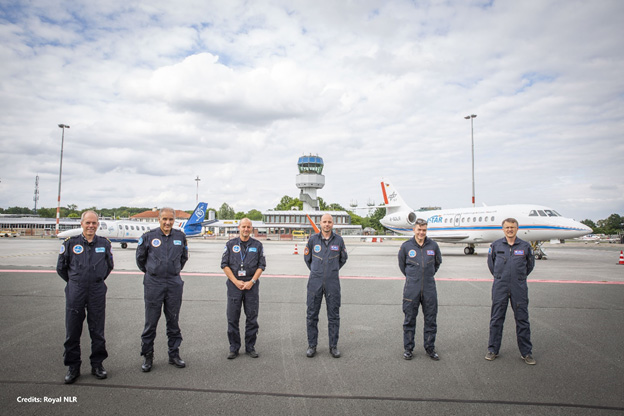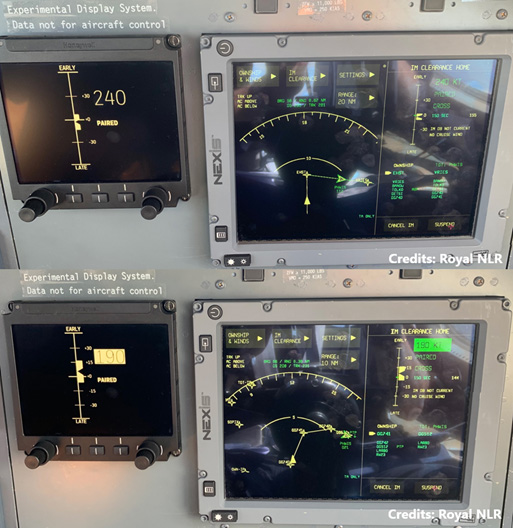
Royal NLR and DLR Flight Test Crew
SESAR partners in The Netherlands successfully carried out flight trials demonstrating a solution to enable aircraft approaching airports to fly fixed routes in continuous descent. Trialled within the context of SESAR’s Integrated TMA, Airport and Runway Operations (ITARO) very large-scale demonstration, the solution is expected to help improve the efficiency and sustainability of aircraft as they approach busy airports.
The Dutch Airspace Redesign Programme (DARP) aims to improve operational efficiency and to reduce the environmental footprint of the operation. One of the key elements is to implement new technologies that provide better operational planning for the air traffic management system; and more importantly, a better adherence to this plan.
At lower altitudes in the terminal manoeuvring area (TMA) under control of LVNL, the Dutch air navigation service -rovider (ANSP), the environmental footprint can be reduced by using fixed routes for departures and arrivals, combined with continuous climbs and continuous descents along those routes. Today, aircraft can already operate on fixed routes with continuous descents. However, with high traffic demand, additional buffers for inter-aircraft spacing have to be considered. Maintaining the required peak-hour capacity then becomes a bottleneck.
One of the promising technologies addressing the bottleneck is Interval Management (IM). IM makes use of a new onboard aircraft system to very precisely control the spacing with a lead aircraft, reducing the need for large inter-aircraft spacing buffers, and thus overcoming the aspect of peak-hour capacity reduction.
The ITARO project successfully demonstrated the IM capability on fixed routes with continuous descent operation in a flight trial involving Royal NLR and the German Aerospace Center (DLR) flight test aircraft. The IM system was jointly developed with Honeywell Inc (USA). by Royal NLR and the German Aerospace Center (DLR) in collaboration with Honeywell
Flight trial setup and initial findings
The IM flight trial was carried out at Groningen Airport Eelde, an airport in the North of the Netherlands. The NLR Cessna Citation II research aircraft was equipped with the IM system and the DLR ISTAR aircraft, a Falcon 2000 LX, was the lead aircraft during most flights. A few flights were executed with a Cessna Citation CJ4 as lead aircraft. The lead and follower aircraft operated approach procedures with fixed routes and fixed profile descents at either 2.0 or 2.5 degrees. These routes have been especially designed for this flight trial. In total, 49 successful IM operations have been performed during 11 flights.
The flight crews of both lead and follower aircraft flew either on the same or on a different fixed routes to runway 23 of Groningen Airport Eelde. In case of using different fixed routes, these routes merged at an intermediate waypoint and thereafter followed a common path to the runway. The lead aircraft flew a standard speed profile, whereas the NLR aircraft was set-up at various time intervals behind the lead aircraft. The aim was to correct the initially applied spacing error (typically +40, -20, -60 seconds) with the use of the IM system generated speed commands in order to bring the spacing error close to zero. The speed commands were displayed in the cockpit and the flight crew’s task was to closely follow those commands.
The result of the IM spacing performance was very good. For illustration: at the so-called crossing point, the spacing error, which is the difference between the planned and actual spacing interval, was between -1.8 and +2.7 seconds for 50% of the cases. The flight crew workload in executing the IM operations was acceptable and it was easy to fly the commanded IM speeds along the fixed routes.

Figure 1 – Interval management cockpit interface
Concluding remarks
The ITARO IM flight trial was succesfully carried out by NLR in co-operation with Honeywell Inc and DLR.
Future projects and developments on the IM system will have to perform an operational evaluation by operating this new system on board of multiple aircraft in a more dynamic environment in combination with interaction with an ANSP.
ITARO Consortium
Partners involved in ITARO are NLR, DLR, NATS, EUROCONTROL, DSNA, INDRA and Heathrow Airport. The flight trial has been supported by LVNL, Groningen Airport Eelde and Honeywell Inc..
This project has received funding from the SESAR 3 Joint Undertaking (JU) under grant agreement No 101017622. The JU receives support from the European Union’s Horizon 2020 research and innovation programme and the SESAR 3 JU members other than the Union.
